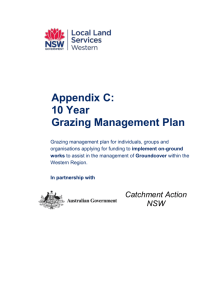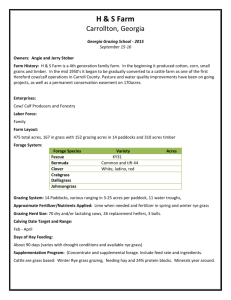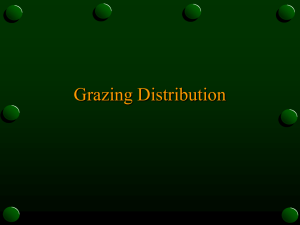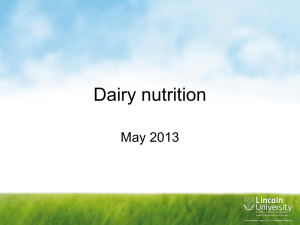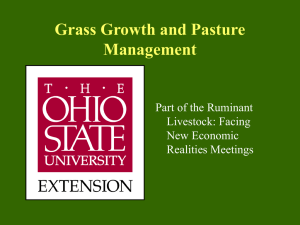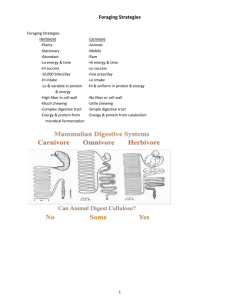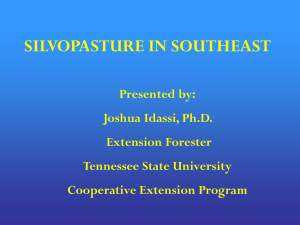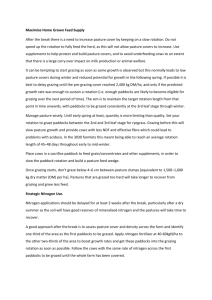Grazing Management and Livestock Health
advertisement
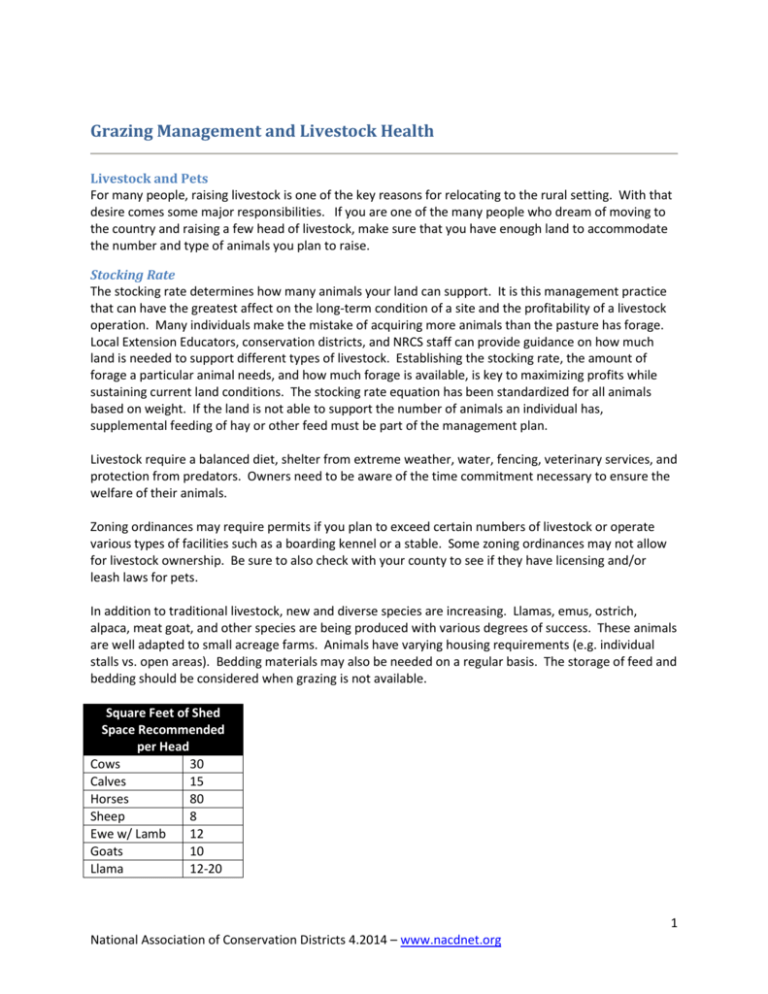
Grazing Management and Livestock Health Livestock and Pets For many people, raising livestock is one of the key reasons for relocating to the rural setting. With that desire comes some major responsibilities. If you are one of the many people who dream of moving to the country and raising a few head of livestock, make sure that you have enough land to accommodate the number and type of animals you plan to raise. Stocking Rate The stocking rate determines how many animals your land can support. It is this management practice that can have the greatest affect on the long-term condition of a site and the profitability of a livestock operation. Many individuals make the mistake of acquiring more animals than the pasture has forage. Local Extension Educators, conservation districts, and NRCS staff can provide guidance on how much land is needed to support different types of livestock. Establishing the stocking rate, the amount of forage a particular animal needs, and how much forage is available, is key to maximizing profits while sustaining current land conditions. The stocking rate equation has been standardized for all animals based on weight. If the land is not able to support the number of animals an individual has, supplemental feeding of hay or other feed must be part of the management plan. Livestock require a balanced diet, shelter from extreme weather, water, fencing, veterinary services, and protection from predators. Owners need to be aware of the time commitment necessary to ensure the welfare of their animals. Zoning ordinances may require permits if you plan to exceed certain numbers of livestock or operate various types of facilities such as a boarding kennel or a stable. Some zoning ordinances may not allow for livestock ownership. Be sure to also check with your county to see if they have licensing and/or leash laws for pets. In addition to traditional livestock, new and diverse species are increasing. Llamas, emus, ostrich, alpaca, meat goat, and other species are being produced with various degrees of success. These animals are well adapted to small acreage farms. Animals have varying housing requirements (e.g. individual stalls vs. open areas). Bedding materials may also be needed on a regular basis. The storage of feed and bedding should be considered when grazing is not available. Square Feet of Shed Space Recommended per Head Cows 30 Calves 15 Horses 80 Sheep 8 Ewe w/ Lamb 12 Goats 10 Llama 12-20 1 National Association of Conservation Districts 4.2014 – www.nacdnet.org Owning Livestock Before buying livestock, apply for a registered brand to assist in legally proving livestock ownership. If livestock stray, or become missing, it is easier to track branded cattle. Owners also have some protection and assurance that missing cattle may be returned. The brand laws apply to the entire state, however, ownership inspection is only required west of the Missouri River. Buying Animals Conducting research prior to buying animals is always a good practice. There are many different breeds of each animal to choose from; be sure to choose the right breed for your land and what you are trying to accomplish. Buy animals from a trusted seller and try to avoid barn sales of culled animals. When buying animals, ask the seller about problems with the herd and vaccination information to make sure there are no red flags. Be aware of the diseases and issues related to your particular animal and consult with the local veterinarian when problems occur. Animal Feeding Operations (AFO’s) and Confined-AFO’s (CAFO’s) CAFO’s and AFO’s are defined by the EPA as “a place where animals are kept in a confined space for at least 45 days in a 12 month period, without any grass or vegetation being present during the normal growing season.” The difference between confined and other feeding operations is based in part by the number of animals that are involved. These operations congregate animals, feed, manure, urine, dead animals, and a production facility on a small area of land. Feed is brought to the animals rather than allowing them to graze or feed in pastures or fields. Due to large concentrations of manure and lack of ground vegetation, these operations can cause great harm to the natural environment because of the risk of pollution during rain events. Implementing vegetation buffers along with a manure management strategy can help reduce the risk of polluted runoff or leachates. Grazing and Livestock Management The plant communities that make up pasture and rangeland are living ecosystems. Land managers need to have a basic understanding of plant growth, soils and nutrient cycling in order to keep their grazing land productive and healthy. Work with your local natural resources professionals to develop a grazing plan that includes determining available forage, water or supplemental water requirements, soil fertility and nutrient availability on your property. Why Manage Grazing? Improve grass health and productivity Increase grazing capacity Improve use of forage supply throughout the year Help control weeds Land stewardship Reduce soil erosion Improve water quality Improve range or pasture condition 2 National Association of Conservation Districts 4.2014 – www.nacdnet.org Are Your Grazing Animals Properly Managed? Do you have so little grass in your pastures that your animals consume dirt while trying to graze? Are your animals browsing on trees, shrubs, fences, or barns? Are your animals losing weight, or are they overweight? Do your animals have scruffy coats? Are your animals prone to colic or respiratory problems? If you answered “yes” to any of these questions, you need a new grazing program that will provide more grass and healthier animals…and save you money in lower feed costs and lower veterinarian expenses! Grazing as a Pasture Management Tool Grazing is one of the best tools available for improvement and maintenance of healthy, productive pastures. Increased infiltration rate, water quality, organic matter, rooting structure, plant health, animal production, and decreased weed invasion, soil erosion, and pesticide use are benefits of proper grazing management. Grazing Methods Timing, intensity, and duration of livestock grazing can have a dramatic impact on individual plant vigor and overall pasture production and rotational grazing. There are two primary styles of grazing available to property owners: continuous and rotational. Providing quality forage throughout the year helps save farmers a considerable amount of money on feed costs. Ideally, animals should graze before pasture crops mature and produce a seed head. After a plant seeds, it will stop growing and is less palatable and nutritious to animals. Pasture crops should reach a height of 6 – 8” before allowing animals to graze. Only 50 percent (3 – 4”) of the crop height should be grazed; otherwise, it will affect the plant’s ability to rejuvenate. Continuous Grazing Continuous grazing typically employs a fixed number of animals grazing a certain number of acres for a given length of time. Continuous grazing, although less labor intensive creates pastures that can be overgrazed and depleted. This is a result of cattle being able to selectively graze the more desirable, nutritious, and palatable plant species first until eventually they have exhausted the good forage species – similar to letting a child choose between ice cream and brussel sprouts. This method of grazing can result in a patchwork of grass, weeds and mud because of the animals’ selectivity. Rotational Grazing Rotational grazing requires more intensive management. This strategy requires property owners to have a base knowledge of their forage crops and an understanding of the animal-pasture interaction to be successful. Forages vary in their optimal grazing heights. Livestock typically are allowed to start grazing in a paddock when the forage (grass or grass/clover mix) is from 8 – 10 inches tall. After the forage is eaten down to approximately 4 inches, livestock are removed and the plants are allowed to rest. This leaves adequate plant leaf area, which enhances the photosynthetic capability of the plant. The more energy the plant receives from the sun the less energy it needs to extract from root reserves. Quicker re-growth occurs from photosynthetic activity and translates into more vigorous plants with 3 National Association of Conservation Districts 4.2014 – www.nacdnet.org increased production. Rotational grazing also results in more uniform grazing of all plant species to a desirable stubble height (length of leaf blade) increasing per-acre production. Rotational grazing allows for more efficient harvesting of sun light. Rotation frequency depends on the amount of forage available, crop type and the number and type of animals foraging. Basic Management Techniques Determine goals and objectives in a management plan. Divide pastures into small units (paddocks) utilizing electric fence and making sure that livestock are trained to the electric fence prior to grazing. Move grazing animals between paddocks to allow recovery time for forage species. Drag pastures to break up and evenly distribute manure, following grazing. Irrigate paddocks following grazing rather than prior to grazing. Take soil samples and fertilize based on the results of the soil test. Have water, salt, and minerals constantly available and dispersed at varying distances will distribute livestock evenly across pasture while keeping them healthy. Adjust animal numbers and management based on pasture production and re-growth. Producers should not allow livestock continuous access to the entire pasture. Grazing on saturated soils or too early in the spring should be avoided. Soil compaction and plant damage can result from grazing livestock in the late fall, winter or early spring. Horses only need 2 – 3 hours of grazing per day allowing for partial intake of their daily nutrient requirement and for exercise. Good grazing management should produce more pounds of product per acre. It will reduce overgrazing and the need to seek feed from other sources. Livestock are healthier and will maintain weight on wellmanaged pasture. Pastures will be productive and be uniformly covered with desired forage species. There will also be a reduction of invasive weedy species. Irrigation will be more efficient with less overland flow of water. Pasture rotation and good grazing management produces more grass, fewer weeds, and no bare ground. Continuous grazing allows weeds to grow where grass roots have been weakened. A less dense leaf canopy allows sunlight to reach invading weeds. Unhealthy Pastures Result in Unhealthy Livestock Some of the livestock issues that can result from grazing on unhealthy pastures are: Colic and respiratory problems from eating dirt Weight loss Parasites Poor coat Tips for a Successful Grazing Program Eliminate continuous season-long grazing by subdividing larger pastures into smaller ones and developing a rotation system – or by finding alternative pasture. Continue year-round rotation to distribute manure, food wastes, and trampling evenly across your pastures or hold animals in a corral. 4 National Association of Conservation Districts 4.2014 – www.nacdnet.org Check your animals frequently to limit amount grazed. Do not leave animals on too long. Avoid overgrazing. Overgrazing occurs when more than 50 percent of the grass plant is removed all at once. Overgrazing stops root growth and reduces grass production. Corral livestock and feed them hay until your pasture grasses are 6” to 8” high. Move livestock when 50 percent of the grass plant has been eaten (3” to 4” height remains). Do not re-graze until grasses are at least 6” high (will take 1 – 3 months). Seasonal instructions: Do not graze too early in the spring, do not graze heavily in fall before dormancy, and during winter months, continue your pasture rotation to distribute manure and feed wastes evenly across your pastures or hold animals in a corral. Allow long rest periods or use a high-intensity, short-duration grazing system to rejuvenate poor condition pasture. Let your grass re-grow. Provide a water source for each pasture. Develop irrigation – if you have water rights – and practice proper irrigation water management. Insufficient irrigation may shorten the life of plants (especially alfalfa), and excess irrigation can drown plants, increase salt problems, promote weed growth, and waste water – and your time. Over-irrigation also can leach nutrients from your soil and cause erosion and fertilizer and pesticide run-off. Irrigate each pasture (if you have irrigation) immediately after grazing to get plants growing again. Do not graze on wet soils due to potential soil compaction and erosion. Horses do not need 24-hour access to feed or forage. Their nutrition needs can be met with only a few hours of grazing on good pasture each day. Corral animals for the remainder of the day to prevent overgrazing of plants and extend the forage available in your pastures. On a limited acreage, you may have only enough pasture to exercise your animals and will need to feed year-round. Practice controlled agricultural burning. Burning of irrigation ditches and pasture should be done with caution. Notify the local fire department before you star – and after you complete – a burn. Fertilize irrigated pastures according to soil test recommendations. Fertilizing normally is not recommended on non-irrigation pastures. Drag or harrow to spread nutrient-rich livestock manure. Control weeds. Reseed, if necessary, following recommendations from the NRCS or your Extension office. What Can I Do to Maintain Sufficient Resting Periods? 1. Subdivide your existing pastures. By subdividing fields we can maintain or increase the resting period while maintaining or shortening the grazing period. For example, if we have eight pastures and need a 50-day resting period per pasture, our grazing periods will be seven days long. If we divide each of those pastures in half to create 16 pastures, we can rest each pasture for 60 days with only four-day grazing periods. 5 National Association of Conservation Districts 4.2014 – www.nacdnet.org 2. Create a sacrifice area – a fenced in area, with little or no vegetations, for animals to stay in while your grass is re-growing. Do You Have Enough Feed and Forage for Your Livestock? Forage is what your animals consume by grazing or what can be harvested for feed. Forage production is generally measured in animal unit months (AUMs). One AUM is equivalent to the amount of forage consumed by a 1,000-pound animal in one month. An animal unit equivalency (AU) for a 1,000-pound cow is the standard used to compare all forage animals. One AU is equal to forage demand of 790 pounds of air-dried forage per month. A horse is equal to 1.25 AU requiring 988 pounds of air-dried forage per month. Feed is the hay or grain that you provide an animal as a supplement or when forage is not available. Hay production is generally measured in tons per acre, and feed is measured in pounds. Q: How much feed and forage do your animals need each year? A: Average requirements are listed below, but may vary with season, level of use, and the age and size of the animal. Feed (Hay) Tons/Month 1 cow 1 horse 1 sheep 1 llama 1 goat .4 .5 .1 .15 .1 Forage AUMs of Grazing/Month 1.2 1.25 .2 .3 .2 Q: How much feed and forage can your land produce? A: Refer to the following table. Fertile Soil Poor Soil Feed (Hay) Forage Feed (Hay) Forage Tons/Acre AUMs/Acre Tons/Acre AUMs/Acre Irrigated 2-4 3-4 Less than 2 1-2 Non-irrigated 1-2 1-2 .5 or less .5 Rangeland/woodland 1 .5 .5 or less .25 These figures are averages and may vary up or down, depending on management. “AUM” stands for “animal unit month.” 6 National Association of Conservation Districts 4.2014 – www.nacdnet.org Q: Do your feed and forage requirements balance with your land? A: To find out, do your own calculations following these examples: Feed Requirements: 3 horses x 0.5 tons per month x 6 months = 9 tons hay Feed Production: 10 acres (fertile non-irrigated soil) x 1 ton per acre = 10 tons hay Forage Requirement: 3 horses x 1.25 AUMs per month x 6 months = 22.5 AUMs Forage Production: 10 acres (fertile non-irrigated soil) x 1 AUM per acre = 10 AUMs In this example, your land will produce enough hay to feed your animals for 6 months. However, you do not have enough forage (grazing) to meet your animals’ needs. To avoid overgrazing your pastures each year: Buy additional feed or rent pasture Increase your pasture production Improve your grazing management Reduce your number of animals Seek assistance Winter Care of Livestock Most livestock can handle wind chills above 20 degrees F without much stress. However, when possible it is best to have a dry place for livestock to escape from cold rains, wet snow and wind. Weather stress can have a detrimental effect on the animal’s health. While natural protection and windbreaks may be adequate, three-sided sheds opening away from prevailing winds are desirable. Allow enough room for livestock to safely lie down without being trampled or smothered. Good clean dry bedding provides insulation from the cold ground. Feed – it is often thought that providing extra grain in cold conditions is the thing to do. However, in reality, livestock produce body heat through the fermentation of fiber, which creates heat while releasing energy. Therefore, good quality grass hay or alfalfa is actually the best source of total digestible nutrients (TDN) for cold weather. The rule of thumb is to plan on feeding 2-3% of an animal’s body weight in dry matter per day. If poor quality forage is fed the volume of hay will need to be increased. Hay contains about 10% water, so if you need to feed 100 lbs of dry you would have to feed 111lbs of hay. Also, weights shown in the table are for actual consumption in dry matter, so include at least 10% more to account for waste. Hay – Rely on your nose, eyes, and hands when purchasing hay. Good hay is usually very green. Green hay has plenty of Vitamin A and the protein is usually of good quality. Brown or bleached out hay will be deficient in Vitamin A and protein denatured. Good hay will smell fresh and grassy, not moldy, musty, damp or dusty. Good hay is tender to the touch with thin, small stems, not coarse with thick stems. The best hay has plenty of protein-rich leaves and relatively few stems. It doesn’t have debris such as weeds, manure, or other foreign materials. Check the maturity. Grass hays should not be fully headed-out; optimally it should contain about 10% heads. Alfalfa should be harvested at about 10-13% bloom. If it’s full of blooms then it is lower in 7 National Association of Conservation Districts 4.2014 – www.nacdnet.org nutrient values. This should really apply to all the feed you buy. Knowing what you are buying will help you in getting the best feed for your dollar. If you are going to buy grass seed straw, you need to make sure the straw has been tested for or is known to be free of toxins caused by endophytes. Endophytes are fungi that produce toxins which are harmful to livestock at high concentrations. One last thing of note: hay can contain noxious and toxic weed seeds. Ensure your hay is purchased from a reputable source as weeds can quickly become a problem for you and your neighbors if allowed to spread. Water Requirements of Animals Note: These are just estimates The following values show the daily minimums for a water system. Hot weather can more than double water requirements and combining this with less succulent forage can increase consumptions four fold. The system may be prohibitive. Be sure to have a back-up plan for hot weather situations. You’ll need to know livestock water needs to design the system and determine if your water source is adequate. If large mobs of livestock run together, the large amount of water required will not only tax the delivery system, but also might be greater than your well, spring or pond recharge capacity. Animal Dairy Cow Beef Cow Pair Yearling Horse Chickens (per 100) Sheep Goat Gallons Water/Day 20 15 10 10 5½ 2 2½ Range 15-25 12-20 6-14 8-14 5-9 2-3 2-3 Stockwater Development Clean, accessible, fresh water is essential for good animal health. Options for stockwater include: 1. A stock tank (keep from freezing) 2. Water gaps on a stream or pond 3. Wind and solar pumps 4. Pipelines from wells and springs How Grass Grows To maintain healthy grass pastures and livestock, a general rule of thumb is to manage grass height so that it ranges between three to eight inches high. These management heights vary by grass species. 8 National Association of Conservation Districts 4.2014 – www.nacdnet.org Graze the pasture when eight inches tall. Rotate the animals to the next pasture when the grass is three inches tall. Grass plants must have adequate leaf area (solar panels) to photosynthesize optimally. Photosynthesis is the process of converting the sun’s energy into plant biomass. Plants with fewer leaves have fewer roots, making it more difficult to absorb necessary nutrients and water from the soil. Grass roots are actively growing in the spring and the fall; the roots are “shedding” in the summer and winter. Grass plants store most of their food reserves in the crown area (bottom two to four inches) of the plant. These stored food reserves consist of sugars and nonstructural carbohydrates. Grasses utilize food reserves for re-growth and to survive periods of dormancy. (Legumes store most of their food reserves in the root.) Growth rates of grasses vary seasonally. The more green leaves, the quicker the plants will re-grow to provide forage for animals. If grass is grazed short when the roots are actively growing (spring and fall), then the summer slump and winter dormancy will negatively affect grass growth even more the following year. Fall is the worst time to graze grass very short. Legumes, like alfalfa and clover, grow better than cool-season grasses in hot weather. Clover can take over an overgrazed pasture in the summer because of its heat tolerance and comparative leaf-area advantage. How Grazing Affects Root Growth Overgrazing occurs when more than 50 percent of the grass plant is removed all at once. Overgrazing stops root growth and reduces grass production. Look what happens when you try to sneak in another 10 percent “harvest” – 50 percent of the roots stop growing! Percent Grass Plant Removed 10% 20% 30% 40% 50% 60% 70% 80% 90% Percent Root Growth Stopped 0% 0% 0% 0% 2-4% 50% 78% 100% 100% 9 National Association of Conservation Districts 4.2014 – www.nacdnet.org Grazing Schedule for a One Herd Multiple-Pasture System – Samples Begin grazing when plants are 6” to 8” in height. Move livestock after 50 percent has been eaten (3” – 4” remains). A minimum of 30 days is needed between grazing periods on irrigated pasture and up to 3 months for non-irrigated pasture. You may need to corral livestock and feed them hay until the pasture re-grows. Sample of a Grazing Schedule in Montana Sample of a Grazing Schedule in Utah 10 National Association of Conservation Districts 4.2014 – www.nacdnet.org What Should You Record? Grazing order of your pastures: It is best to rotate the pasture grazing order each year. For example, if you have five pastures, the first pasture grazed in year one may be pasture 1; the following year you should rotate which pasture is grazed first (2, 3, 4, or 5, but NOT pasture 1). Similarly, you should rotate which pasture is grazed last in the grazing season. Remember that grazing early in the growing season 11 National Association of Conservation Districts 4.2014 – www.nacdnet.org and grazing late in the growing season is hardest on pasture plants. If you rotate this “stress” among pastures, it will protect your overall forage quality. Start grazing and stop grazing dates for each pasture: Noting the start and finish dates of grazing a particular pasture will enable you to get a better handle on your actual forage availability. The decision to start and stop grazing is not based on a calendar; it is based on the grass height and observations of pasture growth and grazing patterns. Remember that in the early spring, when grasses are growing fast, animals may actually start grazing the regrowth before they utilize all the plant species in your pasture. Be observant! Number of animals on the pasture: This will help you determine if you are under or overloading your pastures. General health and productivity of the pasture: Does your pasture appear healthy? Are the plants growing vigorously? Do you observe any weed infestations or any worn or damaged pasture areas? Again, you are recording observations and trying to improve your pasture quality and productivity. Seasonal variations and weather: Storms, dry weather, late freezes, etc. all affect plant growth and hence affect your pasture’s productivity. Recordkeeping of this type of data may help with productivity predictions in the future. Fencing: A Grazing Management Tool Choosing the Right Fence There are many types of fences. Each has advantages and disadvantages. No single factor determines the best type of fence to use. When selecting a fence, consider: Purpose (type of animal you’re keeping in or out) Type of soil material (rocky or deep loam) Terrain Material and labor costs for construction Availability of power Maintenance requirements Weather Visual impact Types of Fencing Advantages 4-Strand Barbed Wire Good control of cattle. Skill and design for construction readily available. Disadvantages Barbed wire may be injurious to horses and llamas. Labor and material costs high. Periodic maintenance required. May be damaged by big game Woven Wire Skill and design for construction readily available. Good control of sheep. Add 2 upper strands of barbed wire for cattle. Labor and material costs high. Some maintenance necessary. 12 National Association of Conservation Districts 4.2014 – www.nacdnet.org Types of Fencing Advantages 4- to 10-Strand Smooth Wire 4- to 5-strand good for horses. 8- to 10strand will contain large, exotic animals or keep big game out. Durable. Disadvantages Labor and material costs high. Periodic maintenance required. Electric Good for establishing pasture rotation program on small acreages. Lightweight, portable, easy to set up or dismantle before and after irrigation. Less expensive. Jackleg Aesthetically appealing. Very durable. Withstands heavy snow. Good in areas where it is hard to dig or drive posts. Can be adapted for marshy, wet areas. Low maintenance. Post and Pole (Rail Fence) Durable. Withstands heavy snowfall. Low maintenance. Weathers poorly. Don’t use in lengths over 1,000 feet. Requires regular maintenance. Needs solar or electric power source. Hog Panels Can be formed into a small, portable pen. Wheels may be attached to make moving easier. Good for establishing rotation grazing for a couple animals on small acreage. Inexpensive and easy to construct. Appropriate for only a few sheep or other small animals. Should be moved once or twice each day. High labor and material costs during construction. High labor and materials costs. Fence Lines Fences and property lines have the potential of causing conflict between neighbors while also providing an opportunity to develop a relationship by working together. It should be the responsibility of each property owner sharing a fence to maintain part of the existing fence and/or share in the cost for constructing a new fence, if necessary. (For more information on Fences, please see the section Planning for Your Land.) Concerns, General Welfare and Safety Tips for Livestock Allow animals to adjust to their new environment. Don’t overcrowd animals – understand their behavior and space requirements. Children are attracted to animals, be aware of this attraction for safety reasons. When planning a vacation, don’t forget to make arrangements for someone to care for your livestock. Provide shelter for animals if possible for improved health and reduced feeding costs. 13 National Association of Conservation Districts 4.2014 – www.nacdnet.org Monitor animal water consumption, keep water open. Pasture Management – Animals on pasture should have access to a windbreak or other shelter to protect them from cold winter winds, hot summer sun, and wet, rainy weather. When introducing livestock, especially horses, to pasture in the spring it is wise to limit access for a few days to decrease the likelihood of colic, founder or other digestive disorders due to an abrupt change in diet. Animals that are moving from the corral to pasture for the first time should be filled with their normal feed to reduce excess hunger. Begin by turning animals out the first day for twenty minutes. Increase this gradually over a week or two. After this adjustment period, it should be safe for them to remain in the pasture full-time. The young growing calf, hard working horse, or pregnant mare may have higher nutritional requirements than pasture alone can provide and may necessitate the addition of a grain mixture. All animals should have access to free choice minerals and salt, and access to adequate quantities of fresh water. The average horse will consume 10 – 12 gallons of water each day. Parasite control – This is a vital part of every health care program. Manure is the primary means through which parasites spread. Manure often contaminates the feed, water supplies, pastures, paddocks, and stalls. Proper manure disposal helps prevent this contamination. Manure should be composted or spread on unoccupied pastures to sun cure. Harrowing or dragging pastures during hot, dry weather helps disperse manure deposits and kills parasite larva by exposing them to the sun. Dragging should not be done where animals are grazing because it distributes the larvae across the grass making it more accessible initially. Bloating – Bloating is a concern for four-stomached animals (ruminants) such as cattle and sheep. Pastures that contain a large percentage of alfalfa or clover pose an increased risk for bloating. Make sure animals are not hungry when they enter these fields and watch them closely. It is recommended that they be filled with dry hay before turn-out, and the time allowed in the legume pasture be restricted initially. Providing bloat reducing supplements decreases the danger of bloat. Windbreaks and Livestock Windbreaks are important for reducing feed and maintenance energy costs for livestock because they reduce wind velocity and, therefore, reduce the effect of wind-chill. This will result in better animal health, lower feed costs and greater financial gain. A Good Health Program is Important Your program should include: Regular de-worming Regular hoof and teeth care A balanced feed ration Shelter Mineral supplements Fresh water and feed 14 National Association of Conservation Districts 4.2014 – www.nacdnet.org The most important factor in a proper health program comes from getting to know your local veterinarian, farrier and other animal health care provider. Proper Waste Management and Pest Control Proper disposal of waste is important in maintaining the health of your livestock. Be aware of the following when planning your management program. How much waste an animal produces per day The odor from waste can attract flies, which may pose health risks Zoning laws may specify waste management programs To dispose of waste, spread the manure, compost or give it away Reducing the manure level decreases flies, parasites and their associated health risks. (See information on Manure Management in the section under Streams, Wetlands, and Water Quality Protection) When spraying for pests, be careful not to contaminate the water and feed sources. It is wise to check with local authorities before beginning a pest control system. (See information on Integrated Pest Management in the section under Predators and Pest Control) 15 National Association of Conservation Districts 4.2014 – www.nacdnet.org References and Further Resources All material in this guide is a compilation of and originated from the following publications. Project Manager, Beth Mason, National Association of Conservation Districts Small Pasture Management Guide (AG 508), Utah State University Cooperative Extension (2008), Utah Hood River County Rural Living Handbook, Hood River Soil and Water Conservation District (2/2008), Oregon Wasco County Rural Living Handbook, Wasco County Soil and Water Conservation District (9/2009), Oregon Deschutes County Rural Living Handbook, Deschutes Soil and Water Conservation District, Oregon Jefferson County Rural Living Handbook, Jefferson County Soil and Water Conservation District (1/2009), Oregon Managing Grazing for Sustainable Pastures, USDA Natural Resources Conservation Service and Colorado State University Extension, Colorado Planning for a Sustainable Homestead, USDA Natural Resources Conservation Service and Colorado State University Extension, Colorado Living on a Few Acres in Wyoming (MP-86), University of Wyoming Cooperative Extension Service, Wyoming Landowning Colorado Style, USDA Natural Resources Conservation Service, Colorado Lake Superior Watershed Rural Property Guide, Superior Watershed Partnership and the University of Wisconsin Extension (2008), Wisconsin Tips on Land and Water Management for Small Farms and Ranches in Montana, Montana Department of Natural Resources and Conservation (1997), Montana Outdoors in Anoka County, Anoka Conservation District and the University of Minnesota Extension Service, Minnesota Rural Lifestyles, Clackamas County Soil and Water Conservation District (11/2009), Oregon Pocket Guide, Clackamas County Soil and Water Conservation District (11/2009), Oregon Jackson County Rural Living Handbook, Jackson Soil and Water Conservation District (10/2006), Oregon Marion County Rural Living Handbook, Marion Soil and Water Conservation District (4/2011), Oregon Best Management Practices for Georgia Agriculture, the Georgia Soil and Water Conservation Commission (3/2007), Georgia 16 National Association of Conservation Districts 4.2014 – www.nacdnet.org Land and Water Management Guide for Non-Urban Areas in Mississippi, Mississippi Soil and Water Conservation Commission, Mississippi Rural Living, South Dakota Association of Conservation Districts, South Dakota Association of RC&D Councils, South Dakota University/Cooperative Extension Service, and USDA Natural Resources Conservation Service (11/15/2004), South Dakota North Dakota Rural Living Handbook, Grand Forks and Cass County Soil and Water Conservation Districts (2009), North Dakota 17 National Association of Conservation Districts 4.2014 – www.nacdnet.org
